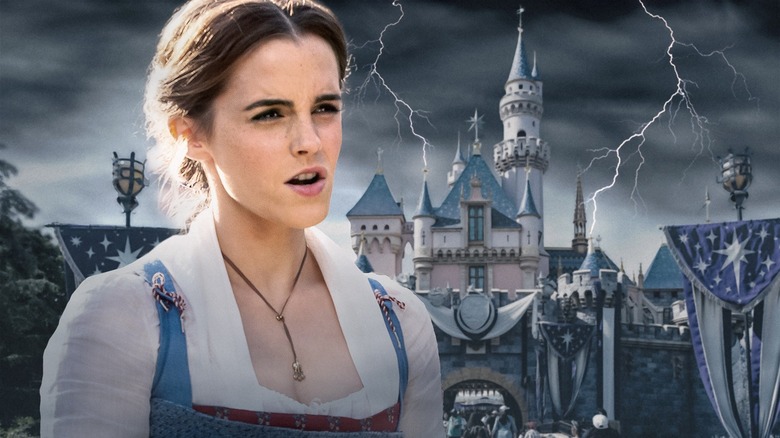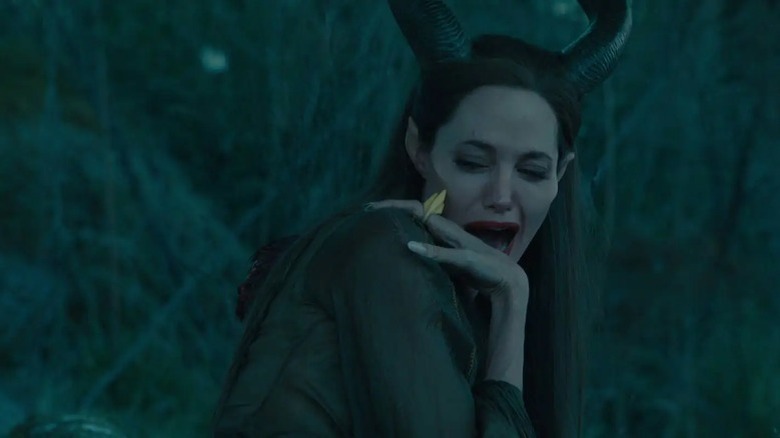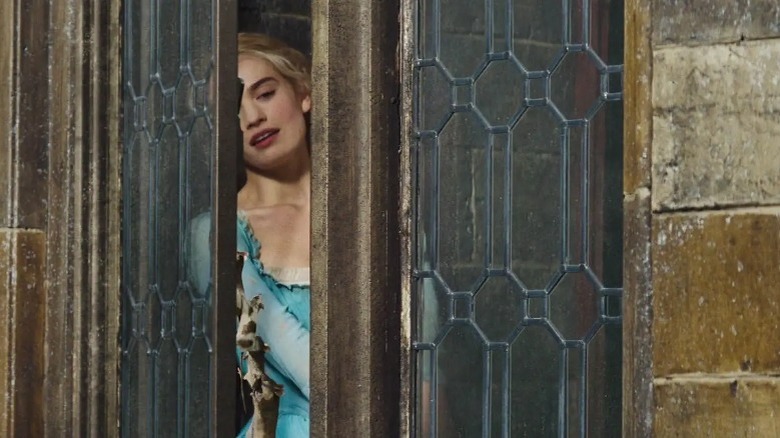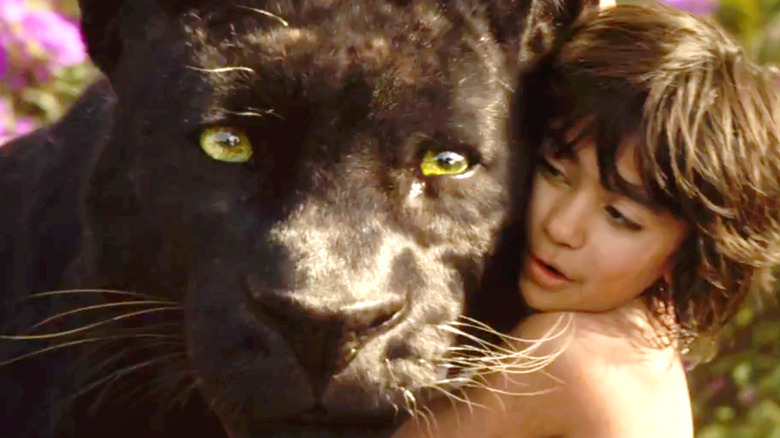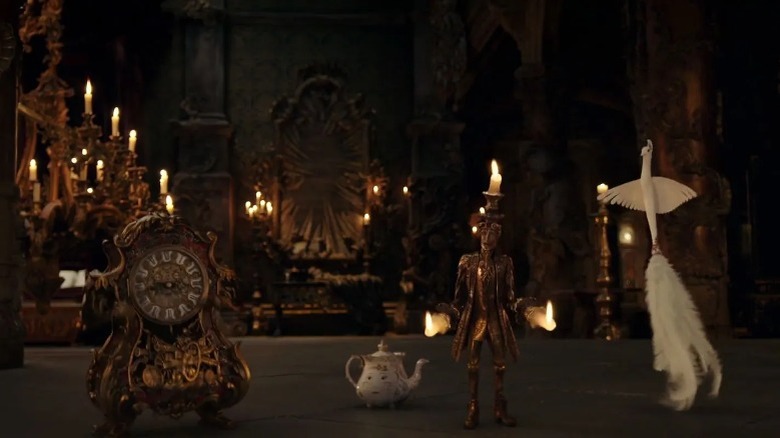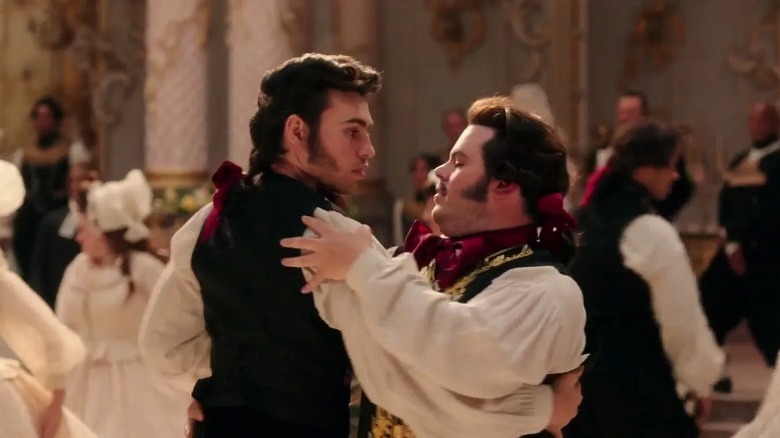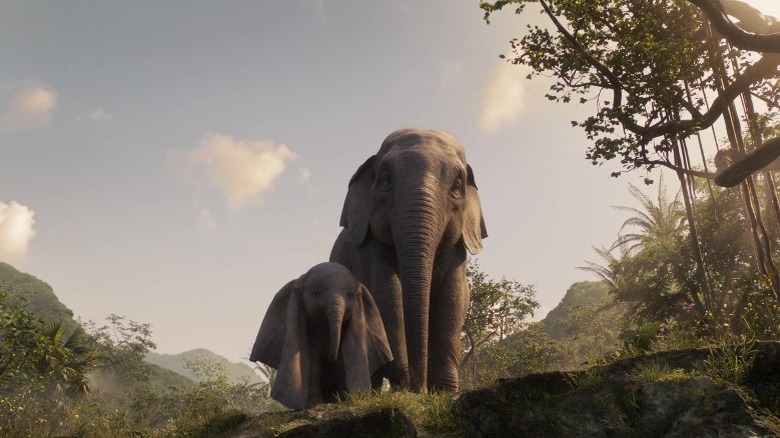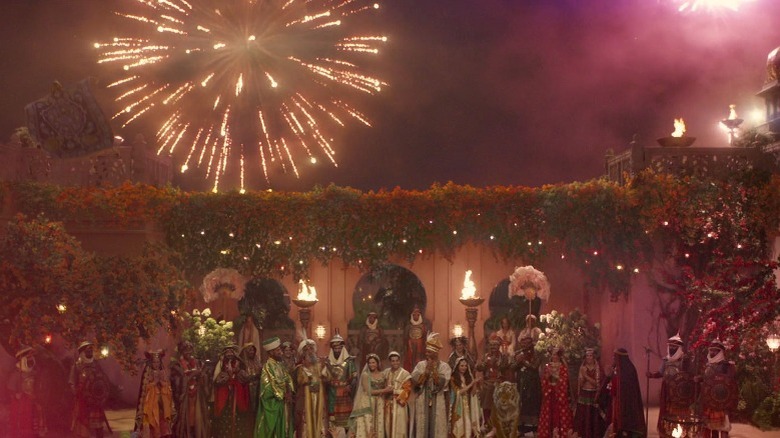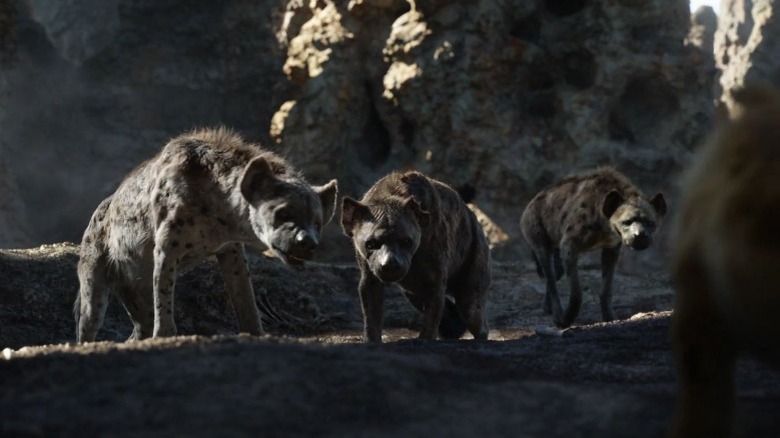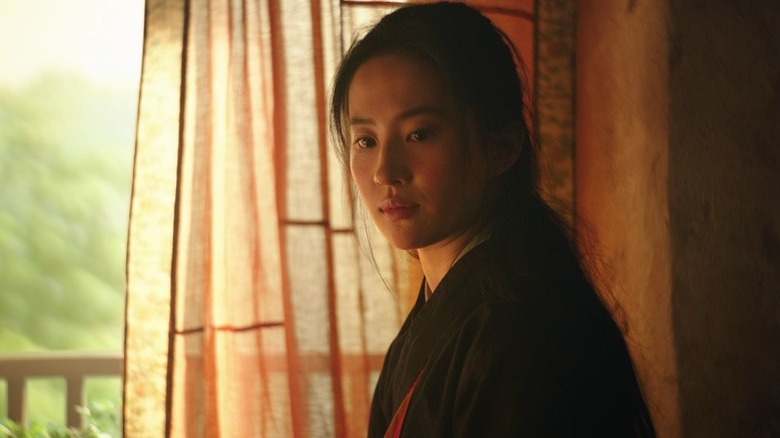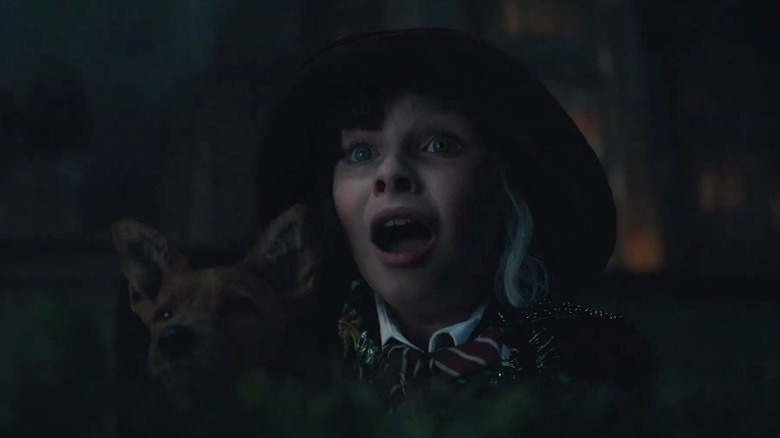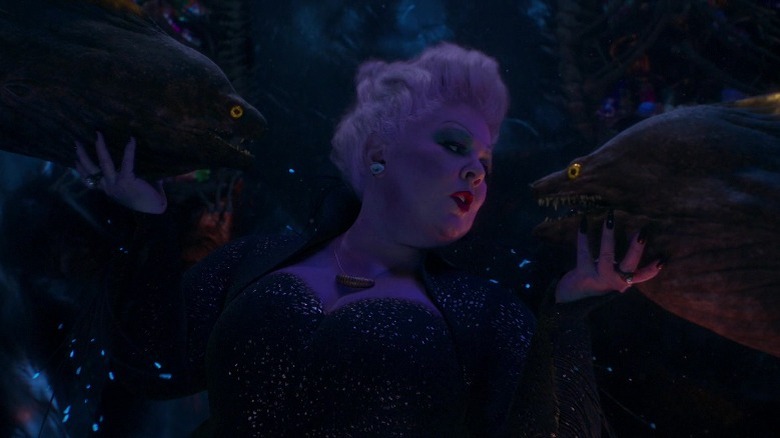Controversial Changes Made In Disney Live-Action Remakes
About a decade ago, Walt Disney Studios found out that it had a veritable gold mine of box office potential just lying dormant in its vault: nearly a century's worth of beloved animated films with decades of built-up nostalgic appeal, which could draw crowds back into theaters just by being faithfully adapted for the live-action medium. Thus, the live-action Disney remake was born.
The remakes in question have, so far, ranged from scrupulously faithful, to cheekily revisionist, to largely indifferent toward their beloved animated counterparts. What they all have in common, though, is the fact that narrative and aesthetic tweaks big or small have been made every single time, even in the most reverent reproductions. And not all of those tweaks have been met with uniform enthusiasm on the part of viewers or critics. These are some controversial changes made in Disney live-action remakes that left fans of the originals baffled.
Maleficent gets a feminist twist — or does it?
On paper, it seemed like a foolproof idea. Take Maleficent, arguably pop culture's most enduring symbol of pure female evil, unbridled and all-consuming in her sheer vindictive pettiness, and twist our understanding of her on its head, thereby calling into question our culture's normative rulebook about what constitutes an "evil woman."
But alas, not everyone agreed with the results. Many critics felt that the choice to "humanize" Maleficent (Angelina Jolie) robbed the character of the bold power and autonomy that made her so iconic in the first place. Plus, the particular way in which "Maleficent" reframes her story was found by some to be reductive and even regressive.
In the film, Maleficent is depicted as a valorous protector turned bitter and vengeful when former lover Stefan (Sharlto Copley) drugs her and cuts off her wings to become king. Maleficent's curse upon Aurora (Elle Fanning) thus becomes an ironic payback to Stefan for destroying her faith in love. In this way, the film inadvertently declares that, at the end of the day, all the Mistress of Evil's rage and cynicism comes from abuse and betrayal suffered at the hands of an ex-boyfriend. As if that representational side-grade from mad witch to woman scorned weren't enough, the film's replacement of Flora, Fauna, and Merryweather with a trio of bumbling, incompetent pixies robs "Sleeping Beauty" of its most progressive gender element.
Cinderella is suddenly a lot more passive
After "Maleficent" got the ball rolling on live-action versions of Disney classics with its revisionist antics, the studio followed it up with a complete 180: a well-behaved, stringently faithful, borderline conservative remake of 1950's "Cinderella." In one crucial respect, however, the 2015 "Cinderella" differs significantly from the original. All of a sudden, the title character — not exactly a model of autonomy or self-affirmation in the original — becomes even more passive and unresponsive to her own abuse.
Where the animated Cinderella at least puts up something of a fight for her modest goals — preparing for the ball, escaping the cellar, not having her dress torn apart — Ella (Lily James) pretty much lets Lady Tremaine (Cate Blanchett) and her daughters (Sophie McShera and Holliday Grainger) push her around at will. Changes to her backstory imply that she consciously stays under Lady Tremaine's boot and follows her orders not just because she's forced to, but as part of an earnest effort to "have courage and be kind" like her parents taught her.
To top things off, when Ella gets locked away in the climax, she literally does nothing but look wistfully out the window and sing. If the mice hadn't opened the darn window and Prince Kit (Richard Madden) hadn't heard her by a stroke of luck, she might have stayed in there for good. This change in character behavior left many viewers not just offended but outright confused. Stand up, girl!
The Jungle Book gets a completely different ending
"The Jungle Book" became notable among Disney live-action remakes not only for its sheer technological advancement — Jon Favreau's "The Lion King" three years later likely wouldn't exist without it — but for being a surprisingly strong film in its own right. Because the original was much older than films like "The Little Mermaid" or "Beauty and the Beast," Favreau and screenwriter Justin Marks had more leeway to play with the story elements without being constantly beholden to nostalgia. And, while the film isn't an all-out revisionist take like "Maleficent," it still manages to subvert the original in at least one big way.
Instead of ending with Mowgli (Neel Sethi) bidding farewell to Baloo (Bill Murray) and Bagheera (Ben Kingsley) and making his way to the man-village like in the animated version, 2016's "The Jungle Book" concludes with an epilogue that shows Mowgli continuing to live in the jungle, still part of the wolf pack and still hanging out with Bagheera and Baloo. That new ending is such a rug pull on expectations that it arrives almost like a jumpscare. It also prompted all manner of discussions about whether it was more or less faithful to the spirit and themes of Rudyard Kipling's book, which has it both ways by having Mowgli move between the jungle and the village throughout his adolescence. There's also the question of whether faithfulness to a text so steeped in colonialist thinking should even be an aim to begin with.
The stakes in Beauty and the Beast get raised — maybe a little too much
While far from the first entry or even the first big hit in Disney's live-action refashioning trend, the Bill Condon-directed "Beauty and the Beast" was the moment when things really went into overdrive. Incidentally, it also marked the first big rupture between film critics and casual fans when it came to expectations and demands made of the studio's live-action "updates." Although the movie was a major audience success, several reviewers were dismayed by decisions made in the new version to "improve" and "deepen" the original film, including one particularly controversial dramaturgical stab at raising the stakes.
The updated script by Stephen Chbosky and Evan Spiliotopoulos changes the nature of the curse placed upon the Beast (Dan Stevens) and his castle so that, if he fails to find true love before the fall of the last petal, instead of staying transformed for good, the castle's servants will permanently freeze into lifeless inanimate objects. As a result, the servants' situation becomes so dire and desperate that it arguably outweighs Belle (Emma Watson) and the Beast's own ostensibly central predicament. When the Beast sets Belle free in a gallant act of self-sacrifice so that she may go save Maurice (Kevin Kline), both star-crossed lovebirds are operating in willful ignorance of the fact that all the castle's residents have just been doomed to die slowly and painfully. It's kind of a tough plot detail to get past.
LeFou, gay icon
At this point, Disney has patted itself on the back so many times for so many different bare-minimum gay representation "firsts" that the phrase "Disney's first gay character" has become a literal Internet meme. But, out of all the instances of Disney seemingly expecting queer viewers to thank it for breadcrumbs of visibility and acknowledgment, the LeFou debacle still stands out as particularly absurd.
The 1991 "Beauty and the Beast" was arguably the magnum opus of gay geniuses like lyricist Howard Ashman — who passed away shortly before the film's release — and villain supervising animator Andreas Deja. It's inextricably a part of queer pop culture history. So it made sense for the remake to be the site of the studio's first-ever introduction of an explicitly LGBTQ+ character. But, out of all the characters who could have been gay, was it really much of a step forward to go with LeFou (Josh Gad), the pathetic doormat henchman of the wicked Gaston (Luke Evans)?
For many queer viewers, the answer wasn't so much a "No" as a sneering, disbelieving chuckle. LeFou, Disney? Really? How much of a win for representation is it, actually, to have your entire studio history's single gay character be a laughable minion smitten with a handsome man to the point of doing his evil bidding? That the "confirmation" of LeFou's sexuality came in the form of an inconsequential blink-and-you'll-miss-it dance with a random man at a ball only made the whole thing more farcical. To the company's credit, Disney has gotten better (in some ways) about queer representation since then. Maybe Internet mockery works when it comes to giant corporations!
Dumbo gets rid of absolutely any and all controversy
The history of early 20th-century American entertainment is rife with ugliness, bigotry, and gleeful reinforcement of noxious social hierarchies — and Disney, inevitably, is no exception. What's unique about the, shall we say, unsavory aspects of Disney's past is that the studio has always made a concerted effort to avoid addressing them. Even when Disney+ finally added content advisory warnings to older films in 2019, for instance, it still kept them markedly vague.
So when Tim Burton's 2019 remake of "Dumbo" opted to deal with the original film's racist crow caricatures by not dealing with them at all, wholly erasing the crows from the film as if they'd never been there instead of retooling them into something new and progressive, some critics found that to be yet another instance of Disney sweeping its past under the rug. And that isn't the only instance of the film's complete avoidance of controversial material actually inviting more Disney "Dumbo" controversy.
The decision to remove the iconic "Pink Elephants on Parade" sequence reeked, to some, of creativity stifled in the name of agreeability. It's not like "baby elephant getting drunk on champagne" is some kind of culturally insensitive stereotype. Plus, the film's "fixed" ending, in which Dumbo and his mother are returned to their original habitat in India and the Medici Family Circus permanently swears off animal cruelty, is so anachronistically progressive for a film set in 1919 as to outright strain credibility.
Aladdin shies away from stereotypes, while also shying away from specificity
Orientalism is a uniquely prickly and far-reaching topic in media analysis, and out of the countless artworks and stories that have contributed to constructing the West's stereotypical image of Asian cultures, Disney's "Aladdin" is a particularly crucial case study. An adaptation of a controversial, centuries-old tale whose popularization in Europe and the United States mirrors the very way in which Orientalism developed throughout the 19th and 20th centuries, the 1992 Disney film is chock-full of exoticism, stereotypes, and racist reductions of Arabs into seething aggressive men and silent, oversexualized women.
The Guy Ritchie-directed 2019 remake attempted to fix all that — and increase the film's global box office potential — by doing away with harmful stereotypes and turning the film's made-up setting of Agrabah from a caricature into a respectful and agreeable celebration of "Arabia." But, in the process, it fell right into what many commentators saw as a different form of Orientalism — one in which the Middle East gets sapped of all specificity or texture, scrubbed of "controversial" elements, including Islam, which got a few passing references in the animated film but goes utterly unmentioned in the remake, and ultimately flattened into a fantastical, amusement-park version of itself, with boundaries of acceptability dictated by Western tastes.
The fact that the film liberally conflates Middle Eastern culture and Indian culture as though interchangeable, staging Bollywood-cribbing musical numbers and casting British Indian actress Naomi Scott as Jasmine, didn't help its case much either.
The Lion King justifies the hyenas' marginalization
Aristocracy has been out of fashion for some time now. It's such a dead political horse, in fact, that in 1994, a rather blatant pro-aristocracy message in a mainstream Hollywood film essentially managed to slip by unquestioned. Sure, "The Lion King" is a cartoon fantasy about talking animals, which makes its celebration of the monarchic "circle of life" and the duties of a king go down more smoothly. None of it is meant to map to our world, after all. The closest the original film gets to breaking the fantasy and peddling some uncomfortable subtext is Scar's mobilization of the oppressed underclass of hyenas to usurp power and establish tyranny, But even so, the logic of it all is too childlike and fantastical to really bother anyone.
Why, then, did the 2019 remake of "The Lion King" feel the need to bring the politics of the Pride Lands, and especially the hyenas' standing, that much closer to real-world logic? Sure, that change is part and parcel with the remake's oft-questioned ethos of providing a "grounded" and "realistic" "Lion King." But the decision to depict the hyenas as antisocial, unquenchable murder beasts who ruin every community they enter goes a step beyond removing facial expressions or draining musical numbers of color. For some critics, it veered right into political discomfort.
In an effort to narratively "justify" the hyenas' banishment from the Pride Lands, the film accidentally exposes its whole plot as a story about why the powerful deserve to be powerful, ditto the marginalized.
Mulan gets revamped into a serious, epic adventure film
The whole wave of Disney live-action remakes has largely been driven by nostalgia. With every new remake announcement, expectations for how individual elements of each film will turn out in live action are born anew. Disney itself has encouraged audiences to expect reiteration and full faithfulness, with marketing focused on shot recreations. In a sense, there was never room in the Disney remake pipeline for something like Niki Caro's "Mulan," and the film's ultimate commercial failure bears that out.
Unlike every other live-action remake before or after it (thus far), the 2020 "Mulan" is pretty much an entirely different film from the 1998 original. Gone are the musical numbers, the cute animal sidekicks, the Huns, and the romance plot. Instead, Disney opted to look back to the Chinese folktale of Hua Mulan itself and adapt it as a more "serious" epic adventure film with only passing similarities to the animated version.
All in all, the finished product is arguably one of the few Disney remakes that can stand fully on its own as a film, as opposed to being an echo of past hits. But that didn't stop it from being roundly rejected by Western audiences who craved something closer to the "Mulan" they knew and loved — nor by Chinese audiences, who hadn't been exactly waiting with bated breath for Disney to give them a marginally more faithful, yet still entirely Disneyfied rendition of their own folklore.
Tragic backstories to all
If there's one big narrative trend running through the Disney live-action remakes, it's the handing out of elaborate backstories to virtually every principal character not previously in possession of one. It's questionable enough when employed as a cheap way to pad out runtimes and needlessly "deepen" stories that worked best in simplified fairytale form, but it's even more questionable when it takes the form of convoluted villain origin stories.
Jafar grew up on the streets in abject poverty. Gaston is a former soldier with PTSD. Ursula was banished by her own brother. Lady Tremaine did what she had to do to make ends meet for her daughters after losing two husbands in a row. Everyone gets a little sympathy. Everyone gets a little understanding. Sometimes, that storytelling philosophy yields something interesting — the "Cinderella" stepmother's angsty monologue is arguably the film's highlight, courtesy of an incredibly committed Cate Blanchett. Mostly, though, it defaults to either offensive fence-sitting or a pointless dulling of those villains' original power and charisma, as best demonstrated not just by the aforementioned "Maleficent" but by 2021's "Cruella."
Some viewers loved Craig Gillespie and Emma Stone's take on Cruella de Vil as a maverick fashion designer antiheroine whose (very much non-murderous) distaste for Dalmatians stems from an incident in which they literally killed her mother. Others, however, found that this Freudian excuse cheapened the main source of Cruella's enduring pop culture appeal: her deranged, unapologetic, utterly over-the-top psychopathy.
The lyrics to Poor Unfortunate Souls get changed
Across the live-action remakes, there have been several instances of Disney altering the lyrics to old hits in its catalog. But none stirred as much controversy as the changes made to "Poor Unfortunate Souls" in the 2023 remake of "The Little Mermaid."
There was no shortage of music-based controversy surrounding this particular movie, from the omission of "Les Poissons" to the overwhelmingly negative audience and critical reception to the new number "The Scuttlebutt." But the decision to remove the entire verse in which Ursula makes a case for voicelessness as the ultimate way to please men, allegedly to avoid sending a regressive message to young girls, stung the most for fans of the original film.
After all, Ursula (Melissa McCarthy) is completely and unambiguously evil — an amoral superpowered villain who's never remotely depicted as a source of wisdom or insight. Not only that, but even if her opinions did hold any credence, she's just saying whatever she needs to say to persuade Ariel (Halle Bailey), not voicing some firmly-held belief. By removing the verse, in fact, Disney threw away a pretty valuable satirical insight — the inevitable endgame of an absolutist "ruffle no feathers" policy.
